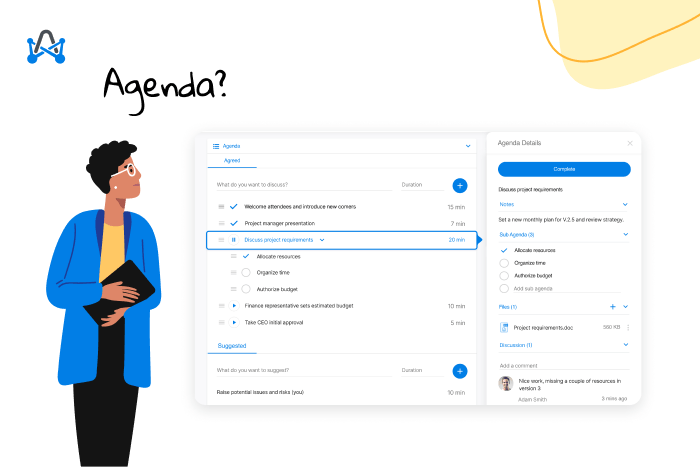July 13, 2020 · 5 min read
What Is a Meeting Agenda? It's 4 Simple Things

Laila El Tawil

Without a meeting agenda, meetings tend to go off-track. You may spend time discussing items that aren't relevant while making no headway on the most important business items that need careful consideration.
Properly planning a meeting gives everyone notification of what will be covered. Not only will this lead to higher levels of engagement during the meeting, people can make a greater contribution when they prepare in advance.
If you've been feeling as though the team isn't making real progress on important business items, perhaps a solution is as simple as implementing this 4-step meeting agenda to guide discussions.
What is a meeting agenda?
A meeting agenda is simply a list of the items you hope to cover during the meeting. Meeting agendas are often structured like an outline, using bullet points or numbers.
This way, the meeting has a more collegial feel, rather than top-down leadership, which facilitates assigning team members to agenda tasks. For instance, the IT guy might talk about the search for video conferencing software, while the HR department will address hiring and recruitment.
Read the following steps to discover the importance of an agenda in a meeting and how to create one.
What to include in a meeting agenda
1. Recurring items
Recurring or standing items are those things that happen at each meeting, usually right when the meeting begins. Standing agenda items look different for every company; let's take a look at a few examples that might belong in this section:
- Meeting attendance
- Approval of last week's meeting minutes
- Updates on status of teams or projects
2. Outstanding or unfinished business
Before moving on to new ideas, meetings should cover unfinished business. Large projects won't get done in between two meetings, so you'll want to allow teams several minutes to update the group on the progress of their project.
This might be a quick update on the hiring process for that new position, where someone shares a draft of the job description or mentions the number of applicants screened.
For a major project, such as a strategic plan, the person in charge can update on the planning process; perhaps a consultant has been found or a strategic plan committee was formed.
The group as a whole may have outstanding business. For instance, a new group may have formed for an advocacy campaign or to plan an annual event. These meetings may be more focused on the campaign or the event, with more of an organic flow between each member's contributions.
Action items due on the meeting date are also discussed during this time. It's common for employees to take charge of one or more tasks in between meetings. Thus, a circle go-round where everyone shares their progress on their action item quickly keeps everyone up to date.
If there are other informational recurring items, such as a meeting outcome of the board or senior leadership, the manager in charge can pass along key points of information at this time.
3. New topics
After the old business has been discussed, focus on future planning and new ideas. There may be time for open conversation and spontaneous brainstorming, particularly if the group is new.
However, it's usually best to place specific items on the agenda that you plan to discuss, such as fundraising ideas or an upcoming switch to a new technology service provider.
This way, the attendees can think of questions or considerations before the meeting, to prompt a more focused and engaged discussion.
4. Housekeeping
Traditionally, a meeting agenda concludes with standing items and housekeeping. Here, you'll ask for announcements of interest to the group, plan the date and time of the next meeting, assign everyone's action items, and tend to any other business not yet handled.
During this section, note any items that merit inclusion on the next meeting agenda so you remember to follow up.
💡 Pro Tip. Use a meeting agenda template and customize it according to your meeting objectives to save time and effort. Don't forget to send a thank you mail after the meeting is finished; it has a positive effect on attendees and enhances meeting productivity.
Editable meeting agenda templates
You can find a list of other useful meetings agenda templates on our blog, which can guide you to hold effective meetings:
- Team meeting agenda template
- Board team meeting agenda template
- Quarterly planning meeting agenda template
- Standup meeting agenda template
- Status meeting agenda template
- First meeting with new team agenda template
- Brainstorming meeting agenda template
- Skip-level meeting agenda template
- Kick off meeting agenda template
- Sales team meeting agenda template
- Retrospective meeting agenda template
If you're looking for smarter enterprise meeting management tools, adam.ai could be your one-step meeting management platform. Give it a try to enjoy all of the meeting management tools with just a few clicks.
And while there may be multiple meeting management solutions available, here is why adam.ai is the all-in-one meeting management platform you can trust:
- adam.ai is one of Atlassian Ventures' portfolio companies.
- In the meeting management software category on G2, adam.ai has been ranked a leader and a high performer for successive quarters in the past years.
- adam.ai has been included in the Forrester Report in the AI-enabled meeting technology landscape.
- adam.ai is trusted and used by powerful teams and organizations worldwide for all types of critical meetings, like board, committee, project management, and business development meetings.
- And most importantly, adam.ai integrates with your existing workflow, is SOC2 compliant, provides dedicated support and success, and has a free trial option.
Transform how you conduct critical meetings—From meticulous preparation to effective execution and insightful follow-up, adam.ai integrates comprehensive analytics, full customization, and intuitive interfaces with powerful meeting management tools.
Easy onboarding. Enterprise-grade security. 24/7 dedicated support.
The bottom line
While the process of creating an agenda for effective meetings seems simple, don't underestimate the impact of an agenda on workplace productivity and morale.
A meeting agenda will help your team prepare for the meeting and make meaningful contributions, which improves the productivity of the meeting.
Subscribe to adam.ai blog
Stay ahead with the latest insights—get our newest blog posts, tips, and updates sent straight to your inbox.